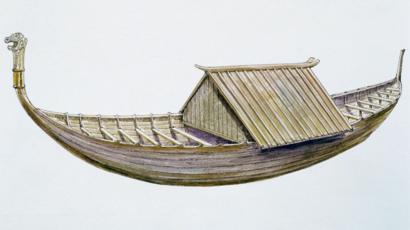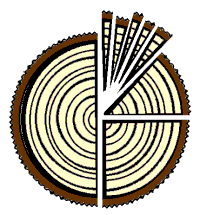@farmerman,
The strakes were made by felling a tall oak tree and then splitting out wedge-shaped sections. The width of the strakes would have been determined by the width of the oak trunk being split. Of course, the strakes overlapped, which is what clinker built means. As you indicated in an earlier post, the Norse were using this method for more than a thousand years for fishing boats and wherries. You also referred to global cooling (if I read you correctly) and the subsequent development of the
knorrir and the longships. This is, of course, speculation, but I agree that the development of the later vessels probably resulted from the warming of the climate after roughly 500 CE. The Greek geographer and historian Strabo reports the account of a Greek merchant from Massilia (modern Marseilles) who had sailed to Bretannikē (Britain) to trade for tin (used in making bronze). The merchant then attempted to sail north looking for (walrus) ivory, but encounter what call brash ice at the northern end of what we call the Irish sea. This period of global cooling was very profound, and is usually considered to have lasted from approximately 500 BCE to 500 CE. Therefore, the Norse would have had no use for any large clinker-built vessels. That is what leads me (and quite a few academic historians) to assume that the
knorrir and the longships were produced beginning the late 7th or early 8th century CE.
It is important to realize that the longships were not sea-worthy in the North Sea (known to the Romans as the German Ocean) or in the Atlantic. They were shallow with very little free board. Although they drew very little water, they'd have been fatally swamped in a North Sea storm, or just heavy weather in the Atlantic. My personal speculation is that the
knorrir were a response to those conditions. In 985, Eirik Raude (Erik the Red) lead the colonizing expedition to what we call Greenland. The short saga, which is the oldest fragment of beginning of the Eirik Raudes saga, ends with the voyage of Bjarni Herjolfsson. Herjolf Bardisson was an Icelandic merchant who had retired from voyaging, and "kept shop" in Iceland while his son Bjarni did the trading voyages. He apparently left very explicit instructions for Bjarni when he, Herjolf, sailed to Greenland. Bjarni returned to Iceland, learned that his father had joined Eirik Reude's colonizing voyage, and kept his cargo, leaving from Bredhafjord, the point of departure of Eirik's expedition. He was hit by a heavy storm, and was drivne southwest for several days. When the storm passed, he kept the sea until the weather cleared. He then sailed northwest, when he sighted land. It is now accepted by historians that he had reached Newfoundland. He coasted (as mariners tended to do in those days) and resisted the pleas of his crew to land. He continued up the coast and then coasted north along the coast Labrador. When he reached what is now called Cape Chidley, and immediately turned east. Running before the constant westerlies, he made landfall at Cape Farewell, the southern most point of Greenland, in under three days. His father, Herjolf Bardisson, and claimed land there so that any merchants arriving at Greenland would reach is little settlement first.
The significance of all of that is that Bjarni's knorr swam in a heavy storm in the North Atlantic. This is something no longship could have survived. Almost all of the longships which have been found, and all those which have been found intact, have been ship burials. One of the most dramatic finds is not Norse, but Aglo-Saxon. At Sutton Hoo, near the coast of Suffolk (the South Folk of East Anglia) in 1939, several mounds were carefully excavated, revealing an extremely rich ship burial. The wood of the ship had rotted away, but the outline of the vessel was preserved in the said, along with iron nails and plates which held it together. The iron was another clue that it was from a very wealthy man. This burial dated from the early 7th century CE, and because of it, I speculate that longships came first, and the
knorrir came later. Eirik Reude and Bjarni Herjolfsson could not have safely made the voyage to Greenland in longships. The Angles or Saxons who sailed to the Suffolk coast would mostlike have hugged the coast of what we call Holland and Belgium, until a man at the masthead could see the coast of Britain. Early the next morning, they would have made the run west to the coast of what became known as East Anglia. Below is an artist's rendering of the ship burial.

Tbe "tent" in the center is the burial chamber.
Here is a link to the British Museum's Sutton Hoo page.[/url[]
Below is an image of how oak logs would have been split to provide the strakes:

Vikings were not a people, they were pirates. Eventually, the people of western Europe learned how to deal with them. At about the same time, the tall, straight oaks of Norway were pretty much exhausted. One of the best ways to stop a Viking attack was to create a plausible threat that you were going to burn their ships. That was what Odda, the Ealdorman of Dorset, did to defeat Ubbe Ragnarsson in 878. Odda and his "militia" and men at arms, occupied an old fort at Cynwit in Dorset. While Ubbe and his danes labored up the slope to the hill fort, some of Odda's men at arms began setting fire to their ships. Ubbe's "army" dissolved in panic, and Odda then attacked downhill. Ubbe was killed in the fighting, although Odda was badly wounded. But the "Viking" threat from the west was ended before King Alfred met Guthrum the Unlucky at the battle of "Ethandun," usually assumed to have taken place at Eddington.